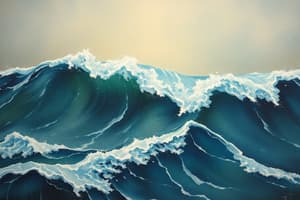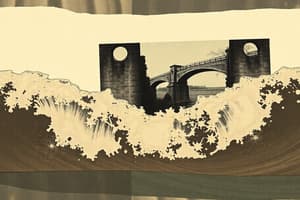Podcast
Questions and Answers
Which statement best describes transverse waves?
Which statement best describes transverse waves?
- They only occur in solids.
- Vibrations are perpendicular to the direction of energy transfer. (correct)
- Vibrations are parallel to the direction of energy transfer.
- They do not transfer energy.
In a longitudinal wave, the vibrations are perpendicular to the direction of energy transfer.
In a longitudinal wave, the vibrations are perpendicular to the direction of energy transfer.
False (B)
What is the term for the distance between the highest point and the midpoint of a wave?
What is the term for the distance between the highest point and the midpoint of a wave?
Amplitude
The highest point of a wave is called the ______.
The highest point of a wave is called the ______.
Match the following terms with their definitions:
Match the following terms with their definitions:
What is the wave equation?
What is the wave equation?
A sound wave in air is an example of a transverse wave.
A sound wave in air is an example of a transverse wave.
If a wave has a speed of 12 m/s and a wavelength of 0.4 m, what is its frequency?
If a wave has a speed of 12 m/s and a wavelength of 0.4 m, what is its frequency?
The distance a surfer travels in a wave of 52 m in 8 seconds results in a speed of ______.
The distance a surfer travels in a wave of 52 m in 8 seconds results in a speed of ______.
What measurement is taken first in the procedure to measure wave speed using a ripple tank?
What measurement is taken first in the procedure to measure wave speed using a ripple tank?
What is a transverse wave?
What is a transverse wave?
What is a longitudinal wave?
What is a longitudinal wave?
Transverse waves only move __ and __ and can be transferred for __ ____. Longitudinal waves only ___ __ and ___ __ a little bit, these are called ______ and ______ where the energy can be transferred for __ ____.
Transverse waves only move __ and __ and can be transferred for __ ____. Longitudinal waves only ___ __ and ___ __ a little bit, these are called ______ and ______ where the energy can be transferred for __ ____.
Sound travels fastest in solids rather than liquids or gases because the particles are ___ ____. The more ___ ___ the particles are the faster the sound travels.
Sound travels fastest in solids rather than liquids or gases because the particles are ___ ____. The more ___ ___ the particles are the faster the sound travels.
What is velocity?
What is velocity?
Which wave type involves vibrations at right angles to the direction of energy transfer?
Which wave type involves vibrations at right angles to the direction of energy transfer?
Longitudinal waves can travel through solids but not through liquids or gases.
Longitudinal waves can travel through solids but not through liquids or gases.
In transverse waves, vibrations are _______ to the direction of energy transfer.
In transverse waves, vibrations are _______ to the direction of energy transfer.
What is the effect called when light rays bend as they travel through different materials?
What is the effect called when light rays bend as they travel through different materials?
Light travels faster through water than it does through air.
Light travels faster through water than it does through air.
What happens to the wavelength of light when it enters a medium like glass?
What happens to the wavelength of light when it enters a medium like glass?
When a wave is ______, it transfers all of its energy to the material.
When a wave is ______, it transfers all of its energy to the material.
Match the following actions to their descriptions:
Match the following actions to their descriptions:
Match the following aspects of the refraction diagram represented by letters to what they are called:
Match the following aspects of the refraction diagram represented by letters to what they are called:
What should the second person do when they see the first person bang the blocks together?
What should the second person do when they see the first person bang the blocks together?
The speed of sound can only be measured over a single distance.
The speed of sound can only be measured over a single distance.
What is the first measurement taken to conduct the speed of sound experiment?
What is the first measurement taken to conduct the speed of sound experiment?
The person holding the wooden blocks begins the experiment by ______ the blocks together.
The person holding the wooden blocks begins the experiment by ______ the blocks together.
Match the steps of the speed of sound measurement procedure with their descriptions:
Match the steps of the speed of sound measurement procedure with their descriptions:
What is the first measurement to be taken when measuring waves using a ripple tank?
What is the first measurement to be taken when measuring waves using a ripple tank?
The speed of sound waves is calculated using the recorded frequency and the wavelength of the metal rod.
The speed of sound waves is calculated using the recorded frequency and the wavelength of the metal rod.
What equipment is used to create wave patterns in a ripple tank?
What equipment is used to create wave patterns in a ripple tank?
To determine the wavelength of waves, you need to measure the length of the screen and divide by the number of _______.
To determine the wavelength of waves, you need to measure the length of the screen and divide by the number of _______.
Match the equipment to its corresponding wave measurement method:
Match the equipment to its corresponding wave measurement method:
What is a common use for ultraviolet waves?
What is a common use for ultraviolet waves?
Gamma rays are primarily used for communication.
Gamma rays are primarily used for communication.
What is the speed of microwave waves in meters per second?
What is the speed of microwave waves in meters per second?
The type of wave used for thermal imaging is ______.
The type of wave used for thermal imaging is ______.
Match the following types of electromagnetic waves with their uses:
Match the following types of electromagnetic waves with their uses:
What happens to visible light when it is too intense?
What happens to visible light when it is too intense?
Higher frequency waves have longer wavelengths.
Higher frequency waves have longer wavelengths.
What is one potential danger of exposure to microwaves?
What is one potential danger of exposure to microwaves?
White light can be split into a spectrum of colors using a ______.
White light can be split into a spectrum of colors using a ______.
Match each type of wave to its corresponding danger:
Match each type of wave to its corresponding danger:
Flashcards
Transverse Waves
Transverse Waves
Vibrations move perpendicular to the direction of energy transfer. Imagine a rope moving up and down, while the wave travels horizontally.
Longitudinal Waves
Longitudinal Waves
Vibrations move parallel to the direction of energy transfer. Think of a spring moving back and forth, while the wave travels along the spring.
Crest/Peak
Crest/Peak
The highest point of a wave.
Trough
Trough
Signup and view all the flashcards
Wavelength
Wavelength
Signup and view all the flashcards
Amplitude
Amplitude
Signup and view all the flashcards
Frequency
Frequency
Signup and view all the flashcards
Period
Period
Signup and view all the flashcards
Wavelength in a Solid
Wavelength in a Solid
Signup and view all the flashcards
Wave Equation
Wave Equation
Signup and view all the flashcards
Refraction
Refraction
Signup and view all the flashcards
Light's speed in different mediums
Light's speed in different mediums
Signup and view all the flashcards
How does light bend?
How does light bend?
Signup and view all the flashcards
Light in a glass block
Light in a glass block
Signup and view all the flashcards
Measuring speed of sound
Measuring speed of sound
Signup and view all the flashcards
Speed of sound
Speed of sound
Signup and view all the flashcards
Measuring the speed of sound
Measuring the speed of sound
Signup and view all the flashcards
Trundle wheel
Trundle wheel
Signup and view all the flashcards
Period (of a sound wave)
Period (of a sound wave)
Signup and view all the flashcards
Frequency (of a sound wave)
Frequency (of a sound wave)
Signup and view all the flashcards
Wave Speed
Wave Speed
Signup and view all the flashcards
Wavefronts
Wavefronts
Signup and view all the flashcards
Scalar Quantities
Scalar Quantities
Signup and view all the flashcards
Vector Quantities
Vector Quantities
Signup and view all the flashcards
Speed of Light
Speed of Light
Signup and view all the flashcards
Electromagnetic Spectrum
Electromagnetic Spectrum
Signup and view all the flashcards
Visible Light
Visible Light
Signup and view all the flashcards
Splitting Light
Splitting Light
Signup and view all the flashcards
Radio Waves
Radio Waves
Signup and view all the flashcards
Microwaves
Microwaves
Signup and view all the flashcards
Infrared Waves
Infrared Waves
Signup and view all the flashcards
X-rays
X-rays
Signup and view all the flashcards
Study Notes
Transverse Waves
- Vibrations are perpendicular to the direction of energy transfer.
- Example: Water waves
Longitudinal Waves
- Vibrations are parallel to the direction of energy transfer.
- Example: Sound waves
Wave Properties
- Wavelength: The distance between two consecutive points in a wave (e.g., crest to crest or trough to trough). Measured in meters (m).
- Frequency: The number of waves passing a point in one second. Measured in Hertz (Hz).
- Amplitude: The maximum distance of a point on a wave from its rest position.
- Period: The time it takes for one complete wave cycle to pass a given point.
Wave Equation
- Velocity of a wave = frequency × wavelength
- Units: Velocity (m/s), frequency (Hz), wavelength (m)
Measuring Waves
- Ripple tank: Used to investigate waves. Steps include: measure frequency, measure distance of 10 wavelengths, divide distance by 10 to get wavelength, use wave equation to calculate speed..
Sound Speed in Different Media
- Sound travels fastest in solids because particles are closest together.
- Sound travels slower in liquids than solids, and slowest in gases.
- Sound waves travel through solids by particles vibrating and colliding with their neighbors. This transfer of vibrations causes the sound to travel through the material.
- Sound waves travel through gases more slowly, causing a delay between when a particle vibrates and the particle next to it vibrates.
- Sound travels fastest in solids, slower in liquids, and slowest in gases.
- In solids, sound travels faster as particles are closer together. In liquids and gases sound travels slower as the particles are further apart.
- Sound travels through a medium by particles vibrating and colliding with neighbors.
Studying That Suits You
Use AI to generate personalized quizzes and flashcards to suit your learning preferences.




